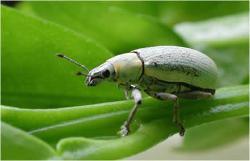Tropical Entomology - Blue Green Weevil
Pachnaeus litus (Coleoptera: Curculionidae)
-
Description

Adult Blue-green weevil (Pachnaeus litus)The adult weevils are bright blue-green to aqua in color and are native to Florida. They are 0.3 to 0.5 inch in length and can be found throughout the year, adult life span is 100 to 120 days. Females oviposit egg masses between two adjacent leaves. The egg masses are deposited in a gelatinous cement that seals the leaves together and provides protection for the eggs. Females lay eggs in clusters of 25 to 50 eggs and can deposit approximately 4000 eggs over their life time. Upon emergence the neonate larvae escape from the sealed leaves and drop to the soil surface. Larvae burrow down to the root system where they begin feeding on fibrous roots.
-
Damage
Part of the plant damaged: Roots, leaves
Adults feed on leaves, leaving characteristic semi-circular notches. The larvae may cause crop damage by debilitating the root system. -
Management
Biological Control
A native egg-parasitoid (Brachyufens osborni (Hymenoptera: Trichogrammatidae)) is considered an important mortality factor of Pachnaeus litus.
Chemical Control

